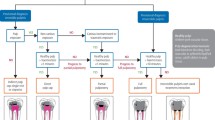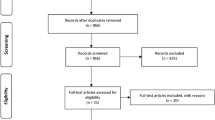Abstract
Background According to the Children's Dental Health Survey 2013, around one in ten children in Wales, Northern Ireland and England will have sustained dental trauma to a permanent incisor by the of age 15. Management of an exposed pulp in an immature permanent incisor is often urgent and has an impact on the long-term outcome of the tooth; therefore, it is essential that general dental practitioners feel confident in managing such a scenario to achieve an optimal outcome. This paper discusses the indications, technique, materials and outcomes.
Aims This article aims to review the literature, which discusses various treatment modalities and materials for pulpal therapy and root canal treatment in the immature permanent tooth.
Method Electronic searches were limited to English language, human studies, published within the past five years and the medical subject heading terms used were: direct pulp capping, apexogenesis, Cvek pulpotomy, full pulpotomy/pulpectomy, partial pulpotomy, apexification, non-vital pulp therapy and mineral trioxide aggregate apexification. Older, seminal articles identified through the references sections have also been included.
Conclusion A number of options are available for the management of immature permanent teeth that have suffered an insult such as caries or trauma. This paper reviews the various methods of pulpal treatment, preservation therapy and root canal treatment options depending on the extent of the damage.
Key points
-
Highlights the management options for pulpal therapy and root canal treatment in immature permanent teeth.
-
Discusses the techniques used for carrying out pulp therapy in immature permanent teeth.
-
Discusses the literature and guidance regarding pulpal therapy in immature permanent teeth.
This is a preview of subscription content, access via your institution
Access options
Subscribe to this journal
Receive 24 print issues and online access
$259.00 per year
only $10.79 per issue
Buy this article
- Purchase on Springer Link
- Instant access to full article PDF
Prices may be subject to local taxes which are calculated during checkout





Similar content being viewed by others
References
Logan W, Kronfeld R. Development of the Human Jaws and Surrounding Structures from Birth to the Age of Fifteen. J Am Dent Assoc 1933; 20: 379-428.
Berkovitz B, Holland G, Moxham B. Oral Anatomy, Histology and Embryology. Edinburgh: Elsevier, 2009.
Andreasen F M, Kahler B. Pulpal response after acute dental injury in the permanent dentition: clinical implications - a review. J Endod 2015; 41: 299-308.
Luder H U. Malformations of the tooth root in humans. Front Physiol. 2015; DOI: 10.3389/fphys.2015.00307.
Andersson L. Epidemiology of traumatic dental injuries. J Endod 2013; DOI: 10.1016/j.joen.2012.11.021.
NHS Digital. Child Dental Health Survey 2013, England, Wales and Northern Ireland. 2015. Available at https://digital.nhs.uk/data-and-information/publications/statistical/children-s-dental-health-survey/child-dental-health-survey-2013-england-wales-and-northern-ireland (accessed March 2022).
Journal of Endodontics. AAE Consensus Conference Recommended Diagnostic Terminology. J Endod 2009; DOI: 10.1016/j.joen.2009.09.035.
American Academy of Paediatric Dentistry. Pulp therapy for primary and immature permanent teeth. The Reference Manual of Paediatric Dentistry. Am Acad Paediatr Dent 2021; 384-392.
Parirokh, M, Torabinejad, M, Dummer P. Mineral trioxide aggregate and other bioactive endodontic cements: an updated overview - part I: vital pulp therapy. Int Endod J 2018; 51: 177-205.
Thompson V, Craig R G, Curro F A, Green W S, Ship J A. Treatment of deep carious lesions by complete excavation or partial removal: a critical review. J Am Dent Assoc 2008; 139: 705-712.
Hilton T. Keys to Clinical Success with Pulp Capping: A Review of the Literature. Oper Dent 2009; 34: 615-625.
Piva E, Da Rosa W L O, Coco A R, Da Silva T M, Mesquita, L C, Galharça A D, Da Silva A F. Systematic review of dental pulp capping materials. Dent Mater 2016; DOI: 10.1016/j.dental.2016.08.185.
Bogen G, Chandler N P. Pulp preservation in immature permanent teeth. Endod Topics 2010; 23: 131-152.
Olsson H, Petersson K, Rohlin M. Formation of a hard tissue barrier after pulp cappings in humans. A systematic review. Int Endod J 2006; 39: 429-442.
Mathur V P, Dhillon J K, Logani A, Kalra G. Evaluation of indirect pulp capping using three different materials: A randomized control trial using cone-beam computed tomography. Indian J Dent Res 2016; 27: 623-629.
Piesiak-Pańczyszyn D, Wrzyszcz-Kowalczyk A, Kobierska-Brzoza J. A Comparison of Selected Regenerative Materials Used in the Management of Pulp Diseases - Review of the Literature. Dent Med Probl 2015; 52: 485-490.
Özgür B, Uysal S, Cem Güngör H. Partial Pulpotomy in Immature Permanent Molars After Carious Exposures Using Different Haemorrhage Control and Capping Materials. Paediatr Dent 2017; 39: 364-370.
Sogupinar A, Arikan V. Comparative evaluation of four endodontic biomaterials and calcium hydroxide regarding their effect on fracture resistance of simulated immature teeth. Eur J Paediatr Dent 2020; 21: 23-28.
Duncan H F, Galler K M, Tomson P L et al. European Society of Endodontology position statement: Management of deep caries and the exposed pulp. Int Endod J 2019; 52: 923-934.
Edwards D, Stone S, Bailey O, Tomson P. Preserving pulp vitality: part two - vital pulp therapies. Br Dent J 2021; 230: 148-155.
Kher M S, Rao A. Contemporary Treatment Techniques in Paediatric Dentistry. Switzerland: Springer Nature, 2019.
Barratt O, Dixon C, Barry S. Technique tips: A complicated crown fracture: The cvek pulpotomy. Dent Update 2017; 44: 1096-1097.
Cvek M. A clinical report on partial pulpotomy and capping with calcium hydroxide in permanent incisors with complicated crown fracture. J Endod 1978; 4: 232-237.
Fong C D, Davis M J. Partial pulpotomy for immature permanent teeth, its present and future. Paediatr Dent 2002; 24: 29-32.
Bimstein E, Rotstein I. Cvek pulpotomy - revisited. Dent Traumatol 2016; 32: 438-442.
Dean J A. Management of trauma to the teeth and supporting tissues. In Dean J E, Jones J E, Walker Vinson L A (eds) McDonald and Avery's Dentistry for the child and adolescent. 10th ed. pp 563-602. Missouri: Elsevier, 2016.
Andreasen J O, Andreasen F M, Andersson L. Textbook and Colour Atlas of Traumatic Injuries to the Teeth. 4th ed. New Jersey: Blackwell Publishing, 2007.
Chacko V, Kurikose S. Human pulpal response to mineral trioxide aggregate (MTA): a histological study. J Clin Paediatr Dent 2006; 30: 203-209.
Ghoddusi J, Forghani M, Parisay I. New approaches in vital pulp therapy in permanent teeth. Iran Endod J 2014; 9: 15-22.
Chen Y, Chen X, Zhang Y et al. Materials for pulpotomy in immature permanent teeth: a systematic review and meta-analysis. BMC Oral Health. 2019; DOI: 10.1186/s12903-019-0917-z.
de Blanco L P. Treatment of crown fractures with pulp exposure. Oral Surg Oral Med Oral Pathol Oral Radiol Endod 1996; 82: 564-568.
Fuks A B, Gavra S, Chosac A. Long-term followup of traumatized incisors treated by partial pulpotomy. Paediatr Dent 1993; 15: 334-336.
American Association of Endodontists. Endodontics Colleagues for Excellence: Endodontic Diagnosis. 2013. Available at https://www.aae.org/specialty/wp-content/uploads/sites/2/2017/07/endodonticdiagnosisfall2013.pdf (accessed December 2020).
American Association of Endodontists. Glossary of endodontic terms. 2020. Available at https://www.aae.org/specialty/clinical-resources/glossary-endodontic-terms/ (accessed March 2022).
Abbott P V. Apexification with calcium hydroxide - when should the dressing be changed? The case for regular dressing changes. Aust Endod J 1988; 24: 27-32.
Lin J-C, Lu J-X, Zeng Q, Zhao W, Li W-Q, Ling J-Q. Comparison of mineral trioxide aggregate and calcium hydroxide for apexification of immature permanent teeth: A systematic review and meta-analysis. J Formos Med Assoc 2016; 115: 523-530.
Mackie I C, Bentley E M, Worthington H V. The closure of open apices in non-vital immature incisor teeth. Br Dent J 1988; 165: 169-173.
Dominguez Reyes A, Muñoz Muñoz L, Aznar Martin T. Study of calcium hydroxide apexification in 26 young permanent incisors. Dent Traumatol 2005; 21: 141-145.
Lee L-W, Hsiao S-H, Chang C-C, Chen L-K. Duration for apical barrier formation in necrotic immature permanent incisors treated with calcium hydroxide apexification using ultrasonic or hand filing. J Formos Med Assoc 2010; 109: 596-602.
Finucane D, Kinirons M J. Non-vital immature permanent incisors: factors that may influence treatment outcome. Endod Dent Traumatol 1999; 15: 273-277.
Phillips J M, Srinivasan V. The management of non-vital immature permanent incisors. Dent Update 2014; 41: 596-604.
Andreasen J O, Farik B, Munksgaard E C. Long-term calcium hydroxide as a root canal dressing may increase risk of root fracture. Dent Traumatol 2002; 18: 134-137.
Grigoratos D, Knowles J, Ng Y L, Hulabivala K. Effect of exposing dentine to sodium hypochlorite and calcium hydroxide on its flexural strength and elastic modulus. Int Endod J 2001; 34: 113-119.
Morse D R, O'Lornic J, Yesilsoy C. Apexification: review of the literature. Quintessence Int 1990; 21: 589-598.
Steinig T H, Regan J D, Gutmann J L. The use and predictable placement of Mineral Trioxide Aggregate in one-visit apexification cases. Aust Endod J 2003; 29: 34-42.
Simon S, Rilliard F, Berdal A, Machtou P. The use of mineral trioxide aggregate in one-visit apexification treatment: a prospective study. Int Endod J 2007; 40: 186-197.
Segura-Egea J J, Castellanos-Cosano L, Martin-Gonzalez J, Alonso-Ezpeleta L O, Lopez Frias F J. Green discoloration of the crown after internal root resorption treatment with grey mineral trioxide aggregate (MTA). J Clin Exp Dent 2011; DOI: 10.4317/jced.3.e404.
Belobrov, I, Parashos P. Treatment of tooth discoloration after the use of white mineral trioxide aggregate. J Endod 2011; 37: 1017-1020.
Parirokh M, Torabinejad M. Mineral trioxide aggregate: a comprehensive literature review - Part III: Clinical applications, drawbacks, and mechanism of action. J Endod 2010; 36: 400-413.
Elumalai D, Kapoor B, Tewrai R K, Mishra S K. Comparison of mineral trioxide aggregate and biodentine for management of open apices. J Interdiscip Dent 2015; 5: 131-135.
Bani M, Sungurtekin-Ekçi E, Odabaş M E. Efficacy of Biodentine as an Apical Plug in Nonvital Permanent Teeth with Open Apices: An In Vitro Study. BioMed Res Int 2015; DOI: 10.1155/2015/359275.
Murray P E, Garcia-Godoy F, Hargreaves K M. Regenerative endodontics: a review of current status and a call for action. J Endod 2007; 33: 377-390.
Banchs F, Trope M. Revascularization of immature permanent teeth with apical periodontitis: new treatment protocol? J Endod 2004; 30: 196-200.
Duggal M, Tong H J, Al-Ansary M, Twati W, Day P F, Nazzal H. Interventions for the endodontic management of non-vital traumatised immature permanent anterior teeth in children and adolescents: a systematic review of the evidence and guidelines of the European Academy of Paediatric Dentistry. Eur Arch Paediatr Dent 2017; 18: 139-151.
Huang G T-J. A paradigm shift in endodontic management of immature teeth: conservation of stem cells for regeneration. J Dent 2008; 36: 379-386.
Galler K M, Krastl G, Simon S et al. European Society of Endodontology position statement: Revitalization procedures. Int Endod J 2016; 49: 717-723.
Kontakiotis E G, Filippatos C G, Tzanetakis G N, Agrafioti A. Regenerative endodontic therapy: a data analysis of clinical protocols. J Endod 2015; 41: 146-154.
American Association of Endodontists. Endodontics Colleagues for Excellence: Regenerative Endodontics. 2013. Available at https://www.aae.org/specialty/wp-content/uploads/sites/2/2017/06/ecfespring2013.pdf (accessed December 2020).
Trevino E G, Patwardhan A N, Henry M A et al. Effect of irrigants on the survival of human stem cells of the apical papilla in a platelet-rich plasma scaffold in human root tips. J Endod 2011; 37: 1109-1115.
Hoshino E, Kurihara-Ando N, Sato I et al. In-vitro antibacterial susceptibility of bacteria taken from infected root dentine to a mixture of ciprofloxacin, metronidazole and minocycline. Int Endod J 1996; 29: 125-130.
Bose R, Nummikoski P, Hargreaves K. A retrospective evaluation of radiographic outcomes in immature teeth with necrotic root canal systems treated with regenerative endodontic procedures. J Endod 2009; 35: 1343-1349.
Rizk H M, Al-Deen M S M S, Emam A A. Comparative evaluation of Platelet Rich Plasma (PRP) versus Platelet Rich Fibrin (PRF) scaffolds in regenerative endodontic treatment of immature necrotic permanent maxillary central incisors: A double blinded randomized controlled trial. Saudi Dent J 2019; 32: 224-231.
Jiang X, Liu H, Peng C. Clinical and Radiographic Assessment of the Efficacy of a Collagen Membrane in Regenerative Endodontics: A Randomized, Controlled Clinical Trial. J Endod 2017; 43: 1465-1471.
Petrino J A, Boda K K, Shambarger S, Bowles W R, McClanahan S B. Challenges in regenerative endodontics: a case series. J Endod 2010; 36: 536-541.
Author information
Authors and Affiliations
Contributions
Anika Shah: first author and corresponding author; involved in initial planning and establishment of MESH terms for literature search; reviewed literature and used this to write the abstract, introduction and non-vital pulp therapy techniques section; digital editing of hand-drawn diagrams; and revisions. Rachel Peacock: first author; involved in initial planning and establishment of MESH terms for literature search; reviewed literature and used this to write the abstract, introduction, vital pulp therapy techniques section and conclusion; illustration of original hand-drawn diagrams; and revisions. Shiyana Eliyas: second author; project supervisor; involved in reviewing article and editing; provided guidance on direction of the article.
Corresponding author
Ethics declarations
The authors declare no conflicts of interest.
Rights and permissions
About this article
Cite this article
Shah, A., Peacock, R. & Eliyas, S. Pulp therapy and root canal treatment techniques in immature permanent teeth: an update. Br Dent J 232, 524–530 (2022). https://doi.org/10.1038/s41415-022-4139-4
Received:
Accepted:
Published:
Issue Date:
DOI: https://doi.org/10.1038/s41415-022-4139-4
This article is cited by
-
Contemporary issues in the management of dental trauma
British Dental Journal (2023)



